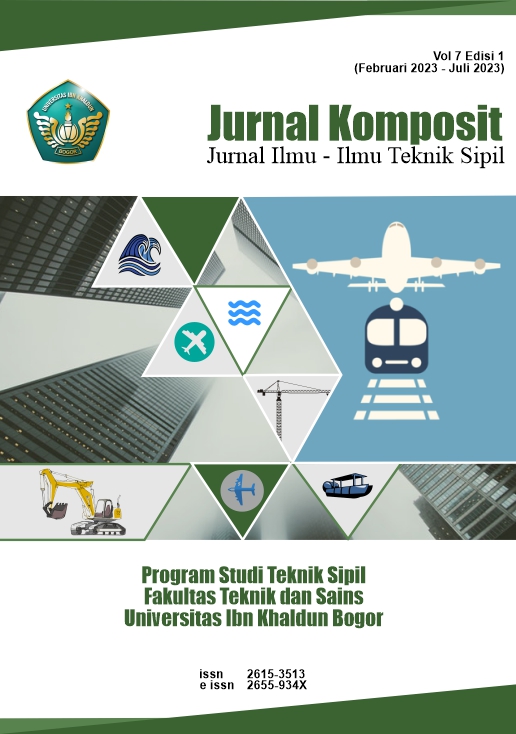Penentuan Karakteristik Tanah Desa Ngasem dengan Metode ASTM
DOI:
https://doi.org/10.32832/komposit.v7i1.9196Abstract
Abstract: Soil is an important part of a sub-building structure, soil characteristics need to be considered in the initial planning of a construction, in order to achieve stability and security for the building above it. With different soil conditions, as is the case with the soil in Ngasem village which has low carrying capacity, it is necessary to know which structure meets the requirements for the soil conditions in Ngasem. To find out the characteristics of the soil is done by testing in the laboratory, namely testing the physical and mechanical properties. Testing the physical properties of the soil is testing the water content (Wc), specific gravity (Gs), Atterberg limits and soil unit weight (γ). Mechanical testing with proctor test and direct shear strength. The method used is an experimental method by taking soil samples at a depth of ± 80 cm and conducting research tests in the Kadiri University laboratory. So that the results of soil classification with the SW-SM code are obtained which are classified as well-graded sandy soils with silt mixtures based on USCS and classified as (A-1-b) according to the AASHTO classification system. The Atterberg Limit of Low Plasticity (clay low plasticity) with a Plastic Index Value of 3.243 which is classified as Slightly Plastic, a shear angle value of 38.748° with a cohesion value of 1.914, a maximum dry unit weight value of 1.77 gr/cm3 , and an optimum moisture content of 14.44 . So that with this study, the community is expected to choose and adjust the type and quality of the structure of building materials in accordance with the state of the land.
Keywords: Soil properties, Compaction, Shear Test, Liquid Limit, Plastic Limit
References
ASTM International. (2000). ASTM D4318 - 00: Standards for Liquid Limit, Plastic Limit, and Plasticity Index of Soils. ASTM International, 04, 1–14.
ASTM International. (2003). ASTM D 3080 - 03: Direct Shear Test of Soilds Under Consolidated Drained Conditions. ASTM International, 04, 7.
ASTM International. (2007). ASTM 698-07: Standard Test Methods for Laboratory Compaction Characteristics of Soil Using Standard Effort (12 400 ft-lbf/ft3 (600 kN-m/m3)). ASTM International, 3, 15.
ASTM International. (2019). ASTM C136/C136M Standard Test Method for Sieve Analysis of Fine and Coarse Aggregates. ASTM Standard Book, 3–7.
Badan Standardisasi Nasional. (2017). SNI 8460-2017 Persyaratan Perancangan Geoteknik. In Persyaratan perancangan geoteknik (Vol. 8460, p. 2017).
Bella, R. A., Bunganaen, W., & Sogen, P. M. (2015). Identifikasi Kerusakan Konstruksi Akibat Potensi Pengembangan Tanah Lempung Ekspansif Di Desa Oebelo. Teknik Sipil, IV(2), 195–208.
Chayati, N., & Taqwa, F. M. L. (2021). Study of Physical and Mechanical Soil Parameters as In-Situ Embankment Materials on Double Track Rail Road Construction Project between Batu Tulis – Ciomas Station, Bogor. Seminar Nasional Ketekniksipilan, Infrastruktur Dan Industri Jasa Konstruksi, 1(1), 73–77. http://prosiding.uika-bogor.ac.id/index.php/kiijk/article/view/345
Direktorat Jenderal Bina Marga. (2018). Spesifikasi Umum Bina Marga Nomor 02/SE/DB/2018. In Edaran Dirjen Bina Marga Nomor 02/SE/DB/2018 (Issue September).
Luthfiani, F., Nurhuda, I., & Atmamto, I. D. (2017). Analisis Penurunan Bangunan Pondasi Tiang Pancang dan Rakit pada Proyek Pembangunan Apartemen Surabaya Central Business District. Jurnal Karya Teknik Sipil, 6(2), 166–179. http://ejournal-s1.undip.ac.id/index.php/jkts
Oumar, K. O., Gilbert François, N. N., Bertrand, M. M., Nathanael, T., Constantin, B. E., Simon, M. J., & Jacques, E. (2022). Mineralogical, Geochemical Characterization and Physicochemical Properties of Kaolinitic Clays of the Eastern Part of the Douala Sub-Basin, Cameroon, Central Africa. Applied Sciences (Switzerland), 12(18). https://doi.org/10.3390/app12189143
Perangin-angin, G. (2009). Studi Potensi Tanah Timbunan Sebagai Material Konstruksi Tanggul Pada Ruas Jalan Negara Liwa - Ranau di Kabupaten Lampung Barat. Rekayasa, 13(2), 141–146.
Prasetio, E., Rismalinda, R., & Ariyanto, A. (2019). Analisa Sifat Fisis Tanah Timbunan sebagai Bahan Material Konstruksi Jalan Desa Koto Tingi. Jurnal Taxiway, 1(1), 46–53.
ÅšrodoÅ„, J. (2013). Identification and Quantitative Analysis of Clay Minerals. Developments in Clay Science, 5(C), 25–49. https://doi.org/10.1016/B978-0-08-098259-5.00004-4
Taqwa, F. M. L., Chayati, N., & Alimuddin, A. (2019). Pemeriksaan Hasil Pelaksanaan Pemadatan Timbunan Tanah di Lokasi Pembangunan Jalan Masuk Gardu Induk PLN, Kasus Pembangunan Gardu Induk PLN Pd. Indah II Kec. Ciputat Timur, Kota Tangerang Selatan. Jurnal Komposit: Jurnal Ilmu-Ilmu Teknik Sipil, 3(2), 53–57. http://dx.doi.org/10.32832/komposit.v3i2.3280
Zhang, T., Cai, G., & Liu, S. (2018). Reclaimed Lignin-Stabilized Silty Soil: Undrained Shear Strength, Atterberg Limits, and Microstructure Characteristics. Journal of Materials in Civil Engineering, 30(11), 1–9. https://doi.org/10.1061/(asce)mt.1943-5533.0002492
Downloads
Published
How to Cite
Issue
Section
License
Copyright (c) 2023 Jurnal Komposit: Jurnal Ilmu-ilmu Teknik Sipil

This work is licensed under a Creative Commons Attribution-ShareAlike 4.0 International License.
Authors who publish with this journal agree to the following terms (Penulis yang mengajukan publikasi artikel telah menyetujui hal berikut):
- Through this publication, the author agree to submit the copyright of article writing to Jurnal Komposit: Jurnal Ilmu-ilmu Teknik Sipil. This copyright submission takes the form of, but is not limited to: reproduction of the article and parts therein, including photographic reproductions; distribution of articles through printed and electronic documents; and translation of articles(Bahwa melalui publikasi ini, hak cipta penulisan artikel diserahkan kepada Jurnal Komposit: Jurnal Ilmu-ilmu Teknik Sipil. Penyerahan hak cipta ini berupa, namun tidak terbatas pada: perbanyakan artikel dan bagian di dalamnya, termasuk reproduksi fotografi; penyebarluasan artikel melalui dokumen cetak dan elektronik; serta penterjemahan artikel).
- The authors agree to the terms of the Copyright Notice, according to Creative Commons Attribution-NonCommercial-ShareAlike 4.0 International License., which will apply to this article if and when it is published by Jurnal Komposit: Jurnal Ilmu-ilmu Teknik Sipil. (Para penulis setuju dengan ketentuan Pemberitahuan Hak Cipta, sesuai dengan Lisensi Internasional Creative Commons Attribution-NonCommercial-ShareAlike 4.0., yang akan berlaku untuk artikel ini jika dan ketika diterbitkan oleh Jurnal Komposit: Jurnal Ilmu-ilmu Teknik Sipil).

This work is licensed under a Creative Commons Attribution-NonCommercial-ShareAlike 4.0 International License.



.png)










